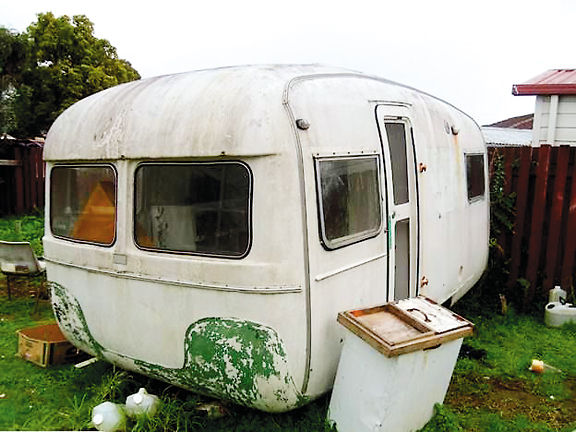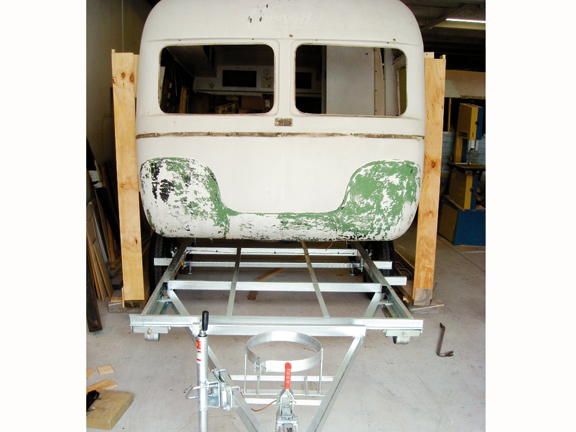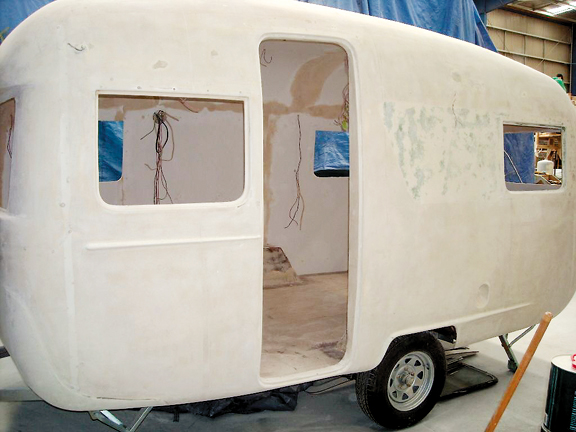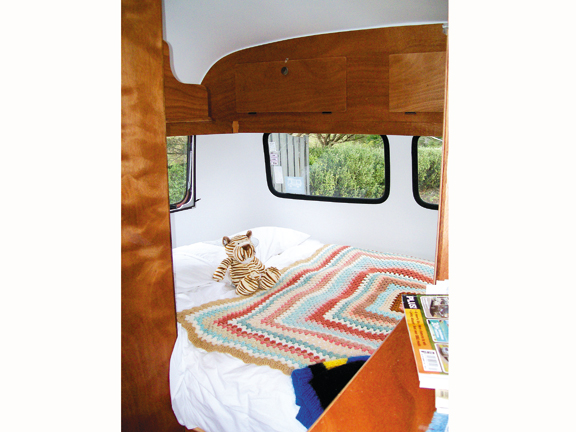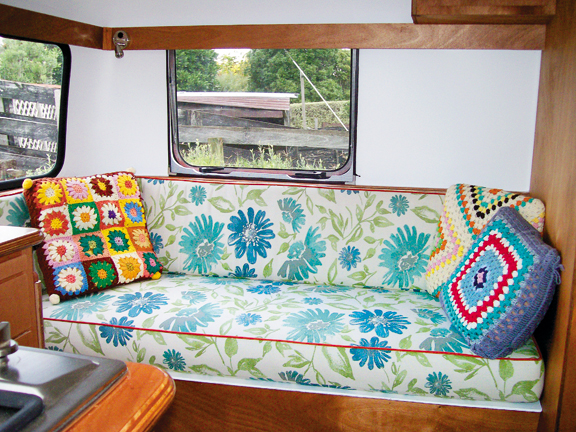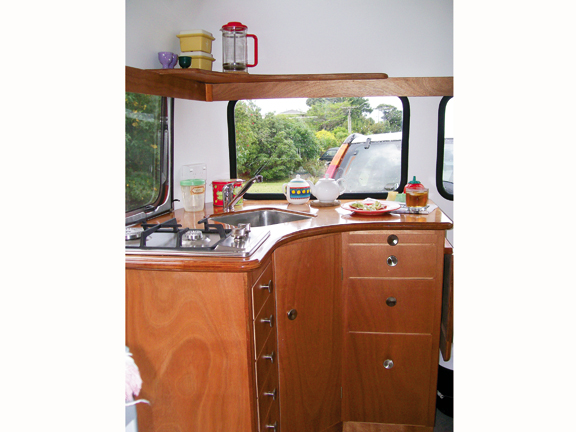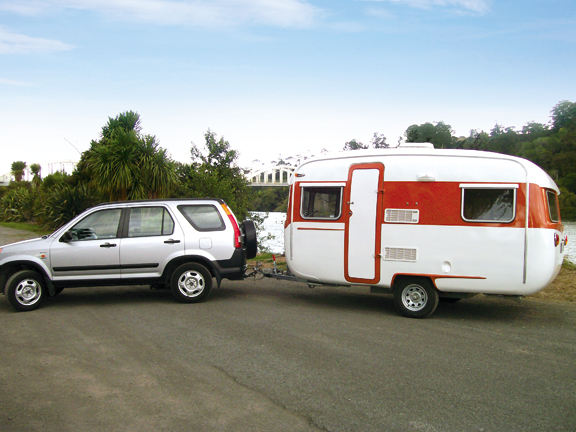I was the first to admit Abe wasn't a looker - far from it - and as an added indignity, he had to be completely stripped.
Lined up against a wall with some other old caravans at an East Tamaki workshop, Abe was 13 feet of ugly, yet as I passed him by I caught a whiff of an old charm beneath the rust, the mouldy paintwork, the sagging tyres, and the taped-shut windows.
I wasn't looking for a caravan. I was there to interview Paul Cooper for a holiday feature in NZX Agri's Country-Wide magazine. Paul restores those retro 'vans which never fail to make Kiwis smile.
He is such a fan of caravans he has built a business out of restoring them. No bach for him: "Give me a caravan, every time. No lawns to mow. Just get in and go."
Abe is a Concord, originally manufactured during the 1960s and '70s. They are made in one piece from fibreglass, so are low-maintenance, lightweight and thus easy to tow, and strong. In recent years there has been a surge in interest in retro caravans, and the distinctive rounded shape of the Concord is in demand. Abe's two-phase door puts his birth date at around 1968.
Abe the Babe was hauled full of rubbish from beneath tangled vines on a back section in Mangere. From there I 'grasped the nettle' and began drip-feeding Paul money for the restoration. His mission was to transform this faded left-out-in-all-weathers memory into an insulated, refitted, rewired, tanked up and repainted retro as good as new - literally a new caravan wrapped in a 44-year-old shell on a brand new chassis.
My only (?!) task was to design the inside to my specifications.
Restoring a caravan is like renovating a house, only on a smaller scale. The same attention to detail is involved as you - the chief planner - decide where to put the new power points; what sort of galley to put in; whether there is to be a shower and a loo; bed configuration; seating, cupboards, what sort of lighting and flooring; roman blinds or curtains, a solar panel, an awning …? It all needs to be decided upon before the rebuild begins.
So as Paul lifted Abe clear of the chassis and sent that away for galvanising, new wheels, a new drawbar, axle, brakes, park jacks and tow hitch, I began scribbling plans for the interior design and layout.
Some 'vanners are retro purists but I wanted a modern interior. The first thing to consider was seating. The space given to this in caravans has always bothered me. If the sun is shining I will be outside with any guests. If it isn't, the fixed double bed across one end of the 'van can become a comfy couch - just add large cushions and a crocheted blanket. (The genuine, all-wool article presented itself in a second-hand shop in Raglan).
So I drew in a single seat of generous width and I will stow a stool that can be pulled up to the table for dinner for two. I found just the thing in a corner of my mother's garage.
Next I wanted to toss the big wardrobe. Who needs it? I plan to be in shorts and t-shirts, or jeans and jersey. Anything dressier can be hung in a slim cupboard below a set of handy shelves.
Another immutable was that I wanted the caravan to be self-contained so that I can park up anywhere - fresh and grey-water tanks and associated plumbing needed to be fitted.
Paul provided a quote for my wish list and I opted for a cassette toilet. A shower adds a bit to the cost so I set that aside - I can get that later if I become a seasoned traveller and upgrade to a 16-footer. For now, it will be a solar shower - 40L of hot water at a one- off cost of about $25 for a bag hung in the sun.
I wanted an old-look lino on the floor and as luck would have it, Flooring Xtra in my home town had a product called marmoleum. Commercial grade, it looks just like what our mothers used to have in their kitchens, and for $300 I could lay it over the whole of Abe's new plywood floor.
By the time I got that to East Tamaki, it was time for another board meeting inside a newly-insulated and wired Abe. More decisions involved overhead lockers - and Paul's advice was to put them only above the bed, to avoid a closed-in feel at head height in the rest of the 'van. Bookshelves would go in any spare nook and cranny, lights were needed by the bed, and vital was a drawer tall enough to stow the bubbly.
Little extras have been bought along the way: a heavy-duty plastic footstool ($39.95) so exiting Abe with wine in hand goes smoothly, and vinyl lettering ($69.95) because Abe needs to have his name up there.
I took advantage of a bed outlet's sale to get a good mattress ($1300) because I don't see the point of going on holiday to get a crook back. Beds R Us in Hamilton kindly stored it for me until Abe was ready. A new gas cooker was sourced online for $310.
Another critical decision had to be made - what colour, and to what degree, on the outside? The trail to this began when I was saying little in my dentist's chair. Rob Aitken suggested I visit a friend of his who had bought Rob's old racing car painted a Toyota colour, Brilliant Persimmon.
"Go and see it, Trena. You'll love it."
So I did, and he was right. That colour became the band around Abe's middle, added dash with a couple of flashes, and delineated the distinctive door. Beautiful.
The interior is white, to give a sense of spaciousness, and the drawer fronts and shelves remain just varnished ply - except for a splash of Brilliant Persimmon on the vanity shelf.
When I got the call from Paul telling me it was time to collect Abe, I had another set of challenges. First, I arranged registration ($92), insurance ($340 a year), and joined the New Zealand Motor Caravan Association ($200). Abe now has fly screens ($500), a solar panel stuck to the roof ($630) and gas and electrical certificates. Other items for the immediate future are roman blinds and an awning.
This caravan was a spur-of-the-moment decision. Now I wonder what it is going to be like to be on the road? Will I like caravanning?
First, though, I am off to buy a wheel clamp ($59.99 on special), because ugly duckling Abe is now looking so darn attractive it is making me nervous.
The restoration process:
- The body of Abe is lifted clear of the chassis, which is then sent off for galvanising, a new drawbar, new axle, new brakes, wheels, tyres, park jacks and tow hitch.
- Interior stripped, then insulated and rewired. The interior walls and ceiling are relined.
- Abe gets a new fibreglass skin, primer, and new paint job. Exterior road lights refitted, door put back - including a new fibreglass inner door, which was missing.
- Windows are replaced, with new rubber fitted on all. Exterior tracks and fittings are reinstated.
- Back to the inside. The lino goes down. A forward galley is built to include two-burner gas hob and basin. Fixed double bed built at rear with drawer beneath.
- Drawer/wardrobe unit built with space for three-way fridge, small desk area above.
- Small toilet area created.
- Fresh and grey-water tanks fitted with associated plumbing.
- Electrical and gas fittings and roadworthiness checked and certified.

